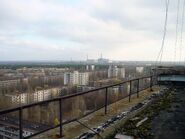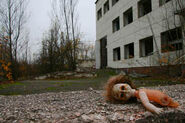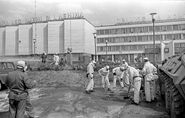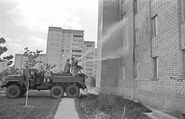|
The cans in the market suddenly stopped having labels. I don't think it was because they ran out of paper.
This page's sources are incomplete, nonexistent or unreliable. You can help the Chernobyl Wiki improve by expanding it.
|

Pripyat, prior to evacuation.
Pripyat [RU: Припять] was a large prefabricated city several kilometres south from the Chernobyl power station that was built to house its workers. Before it was evacuated, the population was between 40.000 and 50.000.
History[]
The area where Pripyat was built was originally forests and swamps inhabited by collective farm serfs. The construction of the city was completed in 1970, seven years before the power plant itself was finished. During this time it was rapidly filled with first the workers to service the power plant and then the people who would service the city.
Before the Accident[]
Life in the City[]

Pripyat in 1979
Pripyat was a large city that was built precisely to modern standards, and the Soviets were very proud of their work. Unlike in other cities, where it would take up to three months, in Pripyat a family would only have to wait a week at most to be assigned to a flat in one of the large, prefabricated buildings. There was a wide variety of products to be purchased in Pripyat, and in the rare instance that someone could not find what they were looking for, it was a short drive south to Kiev or north to Minsk to find it.

First grade classroom in School #5
Education[]
There were five schools in Pripyat, each one grades 1-10, so that the children attending them could simply walk to the closest school. After a child finished his or her last year of high school, they could go again to Kiev or Minsk to their mandatory two years of technical school, which meant they would not even have to leave their home city.
Child Care[]
There were also seven kindergartens in Pripyat, where children ages 2-5 attended while their parents were at work. These were built, much like the schools, to be convenient and close to homes so that it would only be a short walk over. Each one had a large variety of toys and books for children to use while they were there, and the kindergartens had large nurseries to accomadate young children in need of consistent morning and afternoon naps.
Health Care[]
Pripyat was also home to a large hospital, equipped with (at the time) state-of-the-art medical equipment and a large staff of doctors and nurses, several of whom were spouses to plant workers.
Evacuation[]

The evacuation of Pripyat
A video of the Pripyat evacuation, put to music.
In typical Soviet fashion, not only did the government deny that anything had happened at the power plant, they also waited three days to remove the citizens of Pripyat from the danger they were in. On that morning the air raid sirens blew and announcements went out to pack clothing for three or five days. There was also an order to leave pets behind. A fleet of buses arrived in the streets and soldiers, police officers and militiamen herded the startled, confused and ill-informed residents into these buses. None of them would ever live in their homes again, though many would return later to collect items from their flats. Once the buses had departed, army recruits in dust masks and minimal-protection respirators washed the streets and buildings in white foam to remove some of the radioactive fallout. All of the pets in the city were rounded up and killed, because they were a hazard - should they survive, they could absorb heavy contamination in their fur and wander out of the exclusion zone.















